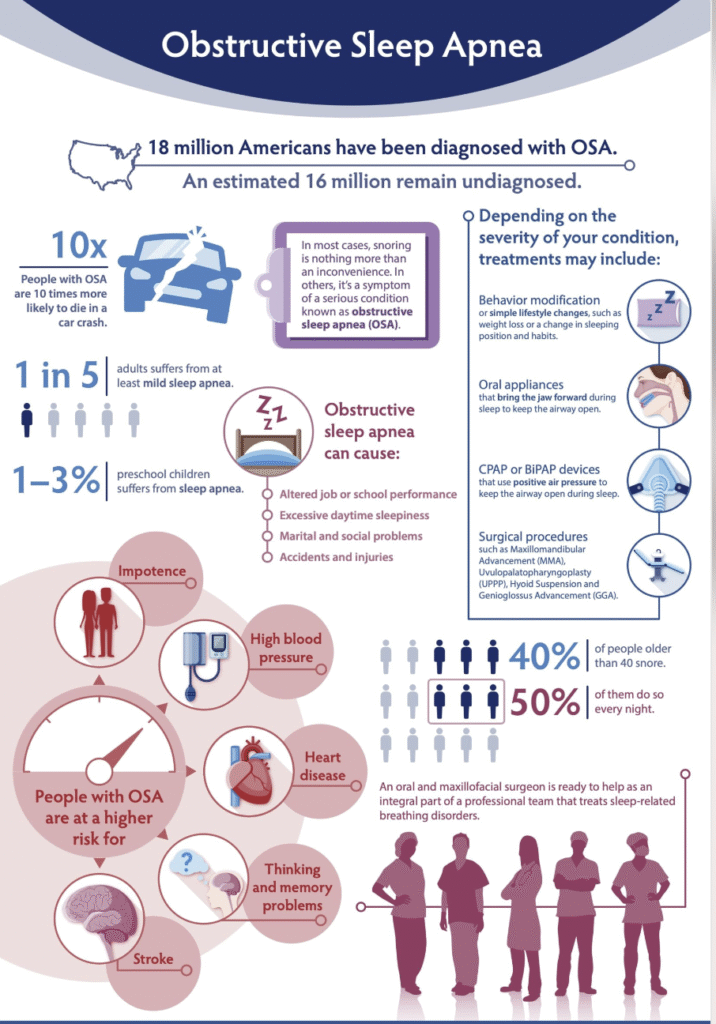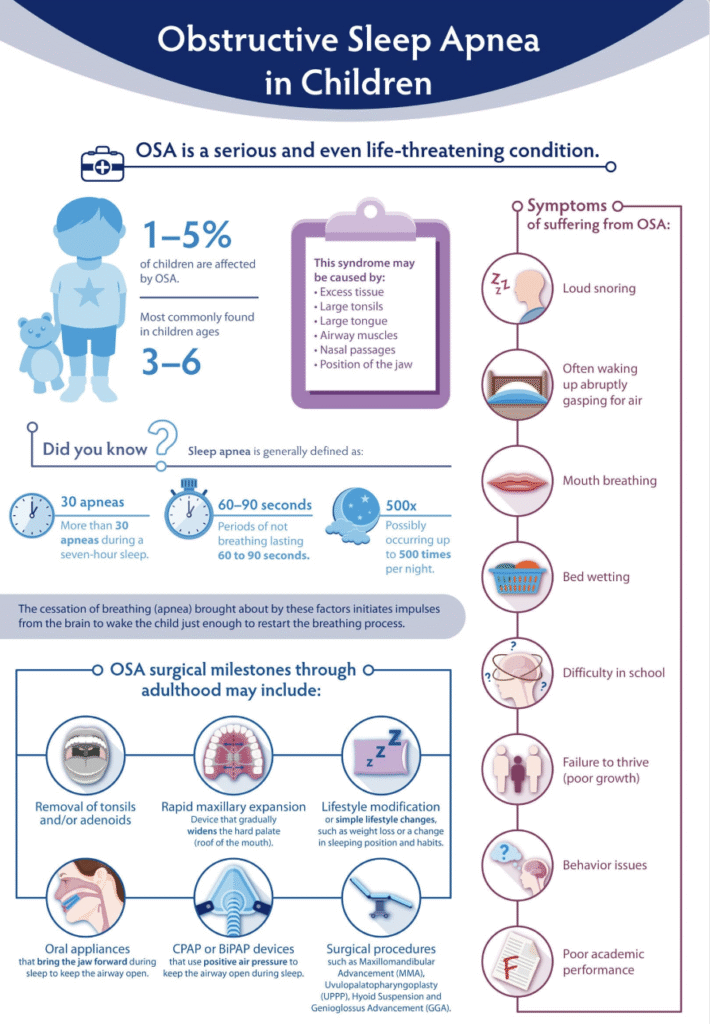Obstructive Sleep Apnea (OSA)
Obstructive sleep apnea (OSA) is a serious and potentially life-threatening condition. Risks of undiagnosed OSA include heart attack, stroke, irregular heartbeat, high blood pressure, heart disease, and decreased libido. Additionally, OSA causes daytime drowsiness, which can lead to accidents, reduced productivity, and relationship difficulties.
The National Sleep Foundation estimates that 18-20 million adults have obstructive sleep apnea, and it likely affects 2–3% of children. Many people with OSA may not realize they have a problem. If someone close to you has mentioned loud snoring or noticed that you often wake up abruptly gasping for air, you should consult your oral and maxillofacial surgeon (OMS).
What Is OSA?
During sleep, the upper airway can be blocked by excess tissue, large tonsils, or a large tongue. Relaxed airway muscles, nasal passage issues, and jaw position can also contribute. Apnea occurs when these factors cause breathing to stop temporarily, prompting the brain to partially awaken the person to restart breathing.
Sleep apnea is generally defined as having more than 30 apneas during a seven-hour sleep. In severe cases, periods without breathing may last 60–90 seconds and can occur up to 500 times a night.
Symptoms of Obstructive Sleep Apnea
- Loud, chronic snoring
- Gasping or choking during sleep
- Excessive daytime sleepiness
- Morning headaches
- Difficulty concentrating or memory problems
- Irritability or mood changes
Diagnosing Sleep Apnea
Diagnosis begins with a detailed medical and sleep history, including information from a bed partner about snoring and breathing pauses. Your OMS may recommend a sleep study (polysomnography) to monitor your breathing, oxygen levels, and sleep stages overnight. Additional imaging of the airway may also be performed to evaluate the anatomy of your nose, jaw, and throat.
Treatment of Obstructive Sleep Apnea
Treatment depends on the severity of OSA. Options include:
- Lifestyle modifications such as weight loss, sleeping on the side, and avoiding alcohol or sedatives before bed
- Continuous Positive Airway Pressure (CPAP) or Bi-level Positive Airway Pressure (BiPAP) devices
- Oral appliances that reposition the jaw or tongue to keep the airway open
- Surgical interventions for patients not responding to conservative therapies
Surgical Procedures Performed by OMS
- Uvulopalatopharyngoplasty (UPPP): Shortens and stiffens the soft palate by partially removing the uvula and reducing the edge of the soft palate.
- Hyoid Suspension: Secures the hyoid bone to the thyroid cartilage to stabilize this region of the airway.
- Genioglossus Advancement (GGA): Tightens the front tongue tendon, reducing tongue displacement into the throat. Often combined with UPPP or hyoid suspension.
- Maxillomandibular Advancement (MMA): Surgically moves the upper and lower jaws forward along with the soft tissues of the tongue and palate, opening the upper airway. For some patients, this is the only technique that creates a sufficient air passageway.
Consult your OMS to determine the most appropriate treatment based on your airway anatomy and the severity of your OSA.
OSA Treatment Options
Personalized Care Based on Severity
Depending on whether your OSA is mild, moderate, or severe, your Oral & Maxillofacial Surgeon (OMS) will select the treatment that is best for you—from behavior modification to oral appliances to air pressure devices. Surgery may be a good alternative for some patients.
Treatment Based on OSA Severity
Mild OSA
- Behavioral modifications (weight loss, sleep positioning)
- Oral appliances (mandibular advancement devices)
- Nasal dilators or allergy treatment
Moderate OSA
- Continuous Positive Airway Pressure (CPAP) therapy
- Custom oral appliances
- Combination therapies
Severe OSA
- CPAP or BiPAP as first-line treatment
- Surgical evaluation if PAP intolerance
- Multi-level surgery options
Surgical Alternatives for OSA
For patients who don’t respond to conservative treatments, these surgical options may be considered:
Uvulopalatopharyngoplasty (UPPP)
Removes excess tissue from the soft palate and pharynx to widen the airway.
Hyoid Suspension
Stabilizes the hyoid bone to prevent airway collapse during sleep.
Genioglossus Advancement (GGA)
Repositions the tongue attachment to prevent airway obstruction.
Maxillomandibular Advancement (MMA)
Advances the upper and lower jaws to physically enlarge the airway.


